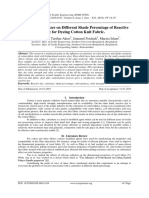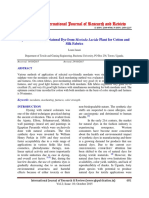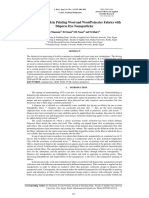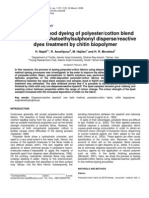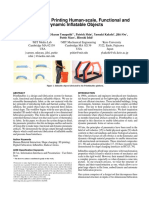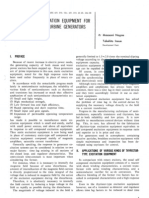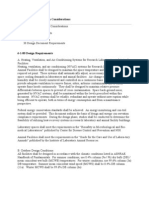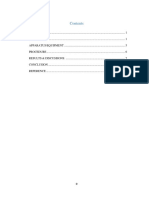Development of Shade Continuity and Wash-Fastness Properties of Reactive Dyed Cellulosic Fabrics .
Development of Shade Continuity and Wash-Fastness Properties of Reactive Dyed Cellulosic Fabrics .
Uploaded by
Rezaul Karim TutulCopyright:
Available Formats
Development of Shade Continuity and Wash-Fastness Properties of Reactive Dyed Cellulosic Fabrics .
Development of Shade Continuity and Wash-Fastness Properties of Reactive Dyed Cellulosic Fabrics .
Uploaded by
Rezaul Karim TutulOriginal Description:
Copyright
Available Formats
Share this document
Did you find this document useful?
Is this content inappropriate?
Copyright:
Available Formats
Development of Shade Continuity and Wash-Fastness Properties of Reactive Dyed Cellulosic Fabrics .
Development of Shade Continuity and Wash-Fastness Properties of Reactive Dyed Cellulosic Fabrics .
Uploaded by
Rezaul Karim TutulCopyright:
Available Formats
Development of Shade continuity and Wash-fastness properties of Reactive dyed cellulosic fabrics .
Introduction
Emphasis on fault prevention and elimination of re-dyeing not only brings substantial water and energy savings but also results in higher quality, increased productivity, reduced labour costs and advantages in supplier-customer partnership. Ferrington1 & Glover et al2 have discussed & calculated impact of re-dyeing cost. Considerable work has been carried out to optimize & ensure maximum reproducibility in dyeing. Reviews on this subject have been published. quality of water, grey preparation, dyeability of substrate, weight of substrate, weighing of dyes & chemicals, selection of dyes, standardization of dye strength (hue), moisture content of dyes and substrate, nature of dye bath, machine flow & sequence, time & temperature profile are factors which are responsible for complexity of dyeing processes. One of these factors, i.e. moisture content of dye powder is recognized as being influential for depth of shade & reproducibility; however only a few quantitative results have been published on its effect & its consequences on dyeing. Adamiake4 reported effect of variations in moisture content of wool dye powder on depth of shade. One reason for variation in moisture content of dye powder is improper storage condition in dyeing factories. Many dyeing factories do not pay attention in storing dyes & chemicals. Stores personnel after issuing dyes & chemicals to production department do not bother to close containers properly. Therefore these dyes & chemicals get exposed to varying temperatures & humidity depending upon seasons. Change in humidity results in change in weight of dye powder. Present work is an attempt to quantify change in depth of shade due to change in humidity. Even though reactive dyes have excellent wash fastness properties, often buyers complain of poor wash fastness. This is mainly due to adherence of hydrolysed dyes onto cotton. If they are not washed off after dyeing, they behave like direct dyes & bleed during initial washings carried out by customers. In order to avoid complaints, some dyers take extra precautions by providing more than required number of washings. Therefore second objective of present study is to develop a quick method to optimize number of washings to be given after reactive dyeing to achieve good wash fastness properties, especially for dark & medium shades.
Materials & methods
Ten Reactive dyestuffs, supplied by M/S Clariant India & M/S Colourtex were taken for study. In order to study effect of varying storage conditions, controlled experiments were carried out at 30C. Dyes (1gm each) were exposed to humidity ranging from 30% to 90% for 5 hours. Change in weight of these dyes was determined. Cotton fabrics were then dyed with conditioned dyes to assess shade consistency by measuring colour difference (E). For purpose of calculating E, fabrics dyed with dye powders, which were conditioned to zero% RH are taken as standard samples. In 2nd study, 100% cotton plain woven fabric was dyed to 2% shade with Procion Red M 8B using laboratory Jigger with M:L :: 1:8. After dyeing fabrics were washed. Following washing procedures were adopted:
1) 1st washing procedure:
Development of Shade continuity and Wash-fastness properties of Reactive dyed cellulosic fabrics .
All cold washes: In this case dyed material was subjected to cold washes. Washings were continued till left over wash liquor was colour-less. From each of above washing stages a swatch was taken out and divided into two parts. One part of swatch was sandwiched between two scoured-bleached cotton fabrics (RFD) and hot pressed by giving one stroke with hot iron (wet press) to assess degree of staining. Stained RFD fabric was analysed for k/s value using CCM. Other part of swatch was tested for colour fastness to washing as per IS 3361 standard test method.
2) 2nd washing procedure:
All cold washes with squeezing at constant pressure in between washes After each wash dyed material was squeezed at constant pressure (30psi) so that amount of carry over Liquor for next wash was reduced. Washing was continued till there was no considerable colour loss (visually observed) in left over liquor. As described earlier, after each wash two samples were cut from fabric for wet pressing i.e. staining test & IS 3361 wash fastness test. Left over liquor after each wash was collected & its optical density was determined using spectrophotometer.
3) 3rd washing procedure:
Intermediate hot wash at strategically chosen point in between cold washes without squeezing In this case dyed material was cold washed twice, followed by hot wash & then two cold washes. Hot wash was carried out at 60C with 2g/l soap. Washing was continued till left over liquor was colour-less.
4) 4th washing procedure:
Intermediate hot wash at strategically chosen point in between cold washes with squeezing In this case effect of hot soap wash as well as squeezing was studied. Here dyed material was given hot soap wash after two cold washes followed by two cold washes. Fabric was squeezed after each wash i.e., for both hot or cold washes. In 3rd part of present study, as suggested by dye manufacturers cotton fabrics were dyed to different shades. After dye fixation, samples were washed in following sequences: Cold overflow rinse for 10mins-Hot rinse at 70C for 10mins-Soaping at 95C for 10minsHot wash rinse at 70C for 10mins-Cold rinse & neutralization for 10min. with acetic acid. In this study also dyed fabric was divided into two parts for wet press & washing fastness test.
Results & discussion
Effect of climatic conditions on dyeing
To evaluate effect of different humidity conditions on reactive dyes, a constant weight of dye powder was exposed to different humidity conditions at 30C. After exposing these dyes were again weighed & used for dyeing. Following are the results. From Tab-1 it is clear that with increase in humidity from zero to 90%, there is an increase in weight of dye due to moisture absorption. Amount of moisture absorbed is found to depend on dye chemistry. At 90% humidity increase in weight is as high as
Development of Shade continuity and Wash-fastness properties of Reactive dyed cellulosic fabrics .
48% for Black & 46% for Golden Yellow. This clearly indicates that during rainy season if storing dye packets/drums is not proper it will significantly affect weight of dyes. This results in shade inconsistency from season to season. Tab-2 shows dyeing behaviour of dye powders, which were kept in various humidity conditions (0 to 90% RH) in terms of colour difference (E). From table it is clear that colour difference of dyed fabric increases with increase in humidity. Reason of this is that with increase of humidity, dye powder absorbs more moisture, which resulted in decrease in strength of dye powder. Presence of high amount of moisture may also result in hydrolysis of dye, thereby giving low colour yield.
Effect of washing on colourfastness
Relationship between K/S value of stained sample after wet pressing & number of washings is shown in Fig-1. From figure it is clear that staining on adjacent fabric decreases with number of washings. It is also clear from figure that if squeezing system is introduced between washes there is a steep decrease in k/s value of stained adjacent fabric. It indicated that after 9 washes staining due to wet press was negligible, while 13 washes are required to get similar results if only cold washes are employed. Fig-2 also supports this observation that if squeezing system is provided between washes, 4-5 grading can be achieved in 9 washings, where as if only cold washes are given it takes 13 washes to achieve similar grading. Similar trends were also obtained with hot soap washes as shown in Fig-3 & Fig-4. But with hot soap wash required results are obtained in 5 washings only. Optical density of wash liquor after each wash was also determined. Graph between changes in optical density of wash liquor after successive washings & number of washes is shown in Fig-6. This graph clearly shows that first cold wash has considerable effect in removing loosely held dye. It can be easily visualized from graph that drop in percentage optical density for first cold wash is nearly 80%. This drop in percentage optical density is quite appreciable. In next four washes effect is less pronounced. When squeezing is carried out between washes, it is seen (Fig-3) that drop in percentage optical density is much steeper. Similar trend was also observed with hot washes (Fig-6) but in hot soap wash drop in percentage of optical density is higher when compared with other methods of washing.
Quick method to evaluate colour fastness to washing of reactive dyes
In this study cotton fabric was dyed in lab model dyeing machine. During washing process, swatches of dyed samples were removed from bath after each washing cycle & squeezed uniformly. Each swatch was divided into two parts.
One part of swatch was placed between two RFD cotton fabrics & ironed by giving in one stroke. All samples were ironed at same temperature. After ironing stained RFD cotton fabrics were assessed for degree of staining with help of CCM. Results are shown in Fig-7a to 7d. From figures, it is clear that to obtain a stain rating of 4-5, number of washes depend on depth of shades; five washes for heavy (3%) & four washes for light & medium (1-2%) shades are required to obtain good fastness properties. Second part of swatches was tested for colour fastness to washing as per IS: 3361. These results are also shown in Fig-7a to 7d. It is clear from figure that fastness rating of staining due to wet press & fastness rating after IS: 3361 wash fastness tests
Development of Shade continuity and Wash-fastness properties of Reactive dyed cellulosic fabrics .
are same. With increase in number of washes, improvement in fastness is similar in both cases thus indicating that staining due to wet press is a quick technique to assess wet fastness properties of reactive dyed material.
Conclusions
1) To control batch-to-batch shade variation dye-stores & laboratory have to play an important role. Stores in-charge should be aware of importance of proper packing & storing of dyes. 2) A considerable saving in energy and water can be achieved by squeezing material after every wash & introducing hot wash at strategically chosen intervals in washing cycle 3) Simple hot pressed method of determining washing fastness is as reliable as approved standard wash fastness method. However, this simple technique needs to be standardized for hot press conditions. 4) Squeezing between two washes help in reducing required number of washes. Therefore it is worth considering modifying conventional jigger so that squeezing could be carried out in jigger. 5) Several attempts were made by machine manufacturers and a few patents were taken about 3 decades back, which emphasized need for incorporating a squeezing mechanism in a jigger to reduce number of wash cycles & thus minimize water consumption. Unfortunately none of these are commercially successful. In present scenario, where water has became scare, it is worthwhile to re-look into this aspect of introducing squeezing mechanism in a jigger.
Development of Shade continuity and Wash-fastness properties of Reactive dyed cellulosic fabrics .
You might also like
- Chemistry Matters Textbook Answers Chapter 3Document3 pagesChemistry Matters Textbook Answers Chapter 3MahamIsmail93% (15)
- Testing of Textile Finished GoodsDocument5 pagesTesting of Textile Finished GoodsRezaul Karim TutulNo ratings yet
- Cat IonizerDocument6 pagesCat IonizerAnonymous 5HRD46hNo ratings yet
- TD Assignment 2Document20 pagesTD Assignment 2palakNo ratings yet
- Fastness Test Textile Testing-Ii: Farhana Momotaz Assistant Professor Dept. of Textile Engineering, KUETDocument28 pagesFastness Test Textile Testing-Ii: Farhana Momotaz Assistant Professor Dept. of Textile Engineering, KUETmehedi ruhitNo ratings yet
- Green University of Bangladesh: Department of Textile EngineeringDocument9 pagesGreen University of Bangladesh: Department of Textile EngineeringGreen University TextileNo ratings yet
- 10 5923 J Textile 20160504 03 PDFDocument5 pages10 5923 J Textile 20160504 03 PDFAkshay DolasNo ratings yet
- Color Fastness of Fabric: Fabric Knowledge For Merchandisers - Submission 3Document11 pagesColor Fastness of Fabric: Fabric Knowledge For Merchandisers - Submission 3Aastika MarwahaNo ratings yet
- Application Methods of Reactive Dyeing - Textile LearnerDocument12 pagesApplication Methods of Reactive Dyeing - Textile LearnerAnas ZidaneNo ratings yet
- National Textile UniversityDocument7 pagesNational Textile UniversityMuhammad Hamza 18-NTU-0106No ratings yet
- Art. No 344 Pag. 13-18Document6 pagesArt. No 344 Pag. 13-18AshutoshNo ratings yet
- Low Liquor Package Dyeing MachineDocument6 pagesLow Liquor Package Dyeing MachineMehmet KacmazNo ratings yet
- Fabric Dyeing MachineDocument8 pagesFabric Dyeing MachineSI ShakilNo ratings yet
- Colour TestingDocument16 pagesColour TestingSana RaufNo ratings yet
- Deying TemperatureDocument12 pagesDeying TemperatureIrtza ArainNo ratings yet
- Comparison of Properties of Cotton Fabric Dyed With Pigment and Reactive DyeDocument5 pagesComparison of Properties of Cotton Fabric Dyed With Pigment and Reactive DyeAwais ImranNo ratings yet
- Ijrr0106 PDFDocument6 pagesIjrr0106 PDFمحمود عامرNo ratings yet
- Application and Performance of Disperse Dyes On Polylactic Acid (PLA) FabricDocument5 pagesApplication and Performance of Disperse Dyes On Polylactic Acid (PLA) FabricMaya PillaiNo ratings yet
- 10 To Study The Effect of Binder Concentration On Fastness Properties of Pigment Printed Fabric.Document6 pages10 To Study The Effect of Binder Concentration On Fastness Properties of Pigment Printed Fabric.Muhammad YaseenNo ratings yet
- Effects of Warp-Weft Density Variation & Fabric Porosity of Cotton Fabrics On Their Colour in Reactive DyeingDocument5 pagesEffects of Warp-Weft Density Variation & Fabric Porosity of Cotton Fabrics On Their Colour in Reactive DyeingRezaul Karim TutulNo ratings yet
- A New Approach in Printing Wool and WoolPolyester Fabrics With Disperse DyeDocument6 pagesA New Approach in Printing Wool and WoolPolyester Fabrics With Disperse Dyefathi mustafaNo ratings yet
- Effect of Dyeing Temperature Variation On Various Properties of Rayon Knitted Fabric Dyed With Reactive DyesDocument6 pagesEffect of Dyeing Temperature Variation On Various Properties of Rayon Knitted Fabric Dyed With Reactive Dyesanik.amit00No ratings yet
- IJAS Volume 12 Issue 2 Pages 4187-4195Document9 pagesIJAS Volume 12 Issue 2 Pages 4187-4195Ekta MoreNo ratings yet
- Comparison of Batch To Batch Shade Variation Considering Parameters in Knit DyeingDocument19 pagesComparison of Batch To Batch Shade Variation Considering Parameters in Knit DyeingMuhammad MustahsinNo ratings yet
- Color FastnessDocument68 pagesColor FastnessSaurabh Singh Rajput100% (5)
- One-Bath Dyeing Process For Polyester Cotton Blend Using Physical Mixtures of Reactive and DisperseDocument11 pagesOne-Bath Dyeing Process For Polyester Cotton Blend Using Physical Mixtures of Reactive and DisperseariefNo ratings yet
- Study On Different Types of Dyeing Faults PDFDocument10 pagesStudy On Different Types of Dyeing Faults PDF呂仲書100% (1)
- 3) Theory of DyeingDocument12 pages3) Theory of DyeingSanaullah Murad100% (1)
- CET 1203 013 Modification Denim Garment Treatment Bleaching PowderDocument7 pagesCET 1203 013 Modification Denim Garment Treatment Bleaching PowderbrkesNo ratings yet
- Optimization of Polyester Printing With Disperse Dye NanoparticlesDocument5 pagesOptimization of Polyester Printing With Disperse Dye NanoparticlesAmi SaNo ratings yet
- Urea FormaldehidDocument4 pagesUrea FormaldehidBening DwipermataNo ratings yet
- Testing Textile Color Fastness To WaterDocument6 pagesTesting Textile Color Fastness To WaterMajor SaahabNo ratings yet
- National Textile University Faculty of Engineering & TechnologyDocument8 pagesNational Textile University Faculty of Engineering & TechnologyShahan AkhtarNo ratings yet
- InkJet Printing PDFDocument9 pagesInkJet Printing PDFNagaraj Goud IreniNo ratings yet
- Colour Theory, Dyes & PigmentsDocument33 pagesColour Theory, Dyes & PigmentsAbhinav Verma100% (3)
- Colour FastnessDocument23 pagesColour FastnessShalini Yadav100% (1)
- Lab ReportDocument6 pagesLab ReportTanzila NusratNo ratings yet
- Arivithamani 2017Document10 pagesArivithamani 2017smmehedih008No ratings yet
- BCR2017110101Document10 pagesBCR2017110101Jelena ReznicNo ratings yet
- Dyeing-Pad Batch AssignmentDocument22 pagesDyeing-Pad Batch AssignmentTooba Anum100% (1)
- 6 PDFDocument9 pages6 PDFLasanthaWimalarathnaNo ratings yet
- A Comparative Studies of Physio Chemical Properties of Linen Yarn Dyed Fabric Dyed With Reactive & Vat DyeDocument7 pagesA Comparative Studies of Physio Chemical Properties of Linen Yarn Dyed Fabric Dyed With Reactive & Vat DyeInternational Journal of Innovative Science and Research TechnologyNo ratings yet
- Effect of Dosing and Run Time (In Respect To Cycle Time) On The Levelness Performance of Knit Dyed FabricDocument5 pagesEffect of Dosing and Run Time (In Respect To Cycle Time) On The Levelness Performance of Knit Dyed FabricRezoanul HaqueNo ratings yet
- Polyester DyeingDocument5 pagesPolyester Dyeingimran1200No ratings yet
- Polyester &cotton Blend DyeingDocument9 pagesPolyester &cotton Blend DyeingPratik RaneNo ratings yet
- Cationization of CottonDocument16 pagesCationization of CottonjitundcNo ratings yet
- Colour Fastness New PDFDocument40 pagesColour Fastness New PDFRafiul IslamNo ratings yet
- Dyeing Behaviour of Differently Degummed Silk Fibers: Vedran Đurašević Waldemar Machnowski & Anna KotlinskaDocument6 pagesDyeing Behaviour of Differently Degummed Silk Fibers: Vedran Đurašević Waldemar Machnowski & Anna KotlinskaThanikai Vimal0% (1)
- Zahid LATIF, Fan LIU, Shu WEN, Shao LONG, Xin-Yue XIAO, Li-Na LIN, Ying-Jie CAIDocument6 pagesZahid LATIF, Fan LIU, Shu WEN, Shao LONG, Xin-Yue XIAO, Li-Na LIN, Ying-Jie CAIShiva ThakuurNo ratings yet
- FTR 33 (1) (2008) 80-87-Effect of Colour On WashingDocument8 pagesFTR 33 (1) (2008) 80-87-Effect of Colour On WashingRaviChandranNo ratings yet
- Color FastnessDocument68 pagesColor FastnessDinesh VermaNo ratings yet
- Method of DyeingDocument4 pagesMethod of Dyeingalhamkarim4No ratings yet
- 181-031-811 (Lab 09) PDFDocument5 pages181-031-811 (Lab 09) PDFZifanislamNo ratings yet
- Salt and Alkali Free Reactive Dyeing On Cotton Fabric (Part-2) - Textile LearnerDocument15 pagesSalt and Alkali Free Reactive Dyeing On Cotton Fabric (Part-2) - Textile LearnerAnas ZidaneNo ratings yet
- Open Access Scientific Reports: Optimization of Caustic Soda Concentration For Causticization of CottonDocument6 pagesOpen Access Scientific Reports: Optimization of Caustic Soda Concentration For Causticization of CottonvinayakasisNo ratings yet
- Internship Report (Dyeing) On Zaheen Knitwear's Ltd.Document21 pagesInternship Report (Dyeing) On Zaheen Knitwear's Ltd.MD. Ibrahim KhalilNo ratings yet
- Evaluation of Appearance Retention of FabricDocument69 pagesEvaluation of Appearance Retention of FabricpsbhirudNo ratings yet
- Salt Free Reactive Dyeing On Cotton (Cationized) Knit FabricDocument10 pagesSalt Free Reactive Dyeing On Cotton (Cationized) Knit FabricAyman sebaeiNo ratings yet
- Handbook of Renewable Materials for Coloration and FinishingFrom EverandHandbook of Renewable Materials for Coloration and FinishingMohd YusufNo ratings yet
- Role of A Merchandiser in Clothing IndustriesDocument8 pagesRole of A Merchandiser in Clothing IndustriesRezaul Karim TutulNo ratings yet
- A Short View of Textile FibresDocument17 pagesA Short View of Textile FibresRezaul Karim TutulNo ratings yet
- Textile Mills Point Source CategoryDocument29 pagesTextile Mills Point Source CategoryRezaul Karim TutulNo ratings yet
- Cost Comparison of Yarn Manufacturing in Different CountriesDocument3 pagesCost Comparison of Yarn Manufacturing in Different CountriesRezaul Karim Tutul100% (1)
- Dyeing Method & Characteristics of Natural Dyestuffs.Document2 pagesDyeing Method & Characteristics of Natural Dyestuffs.Rezaul Karim TutulNo ratings yet
- Factors Affect Color Fastness of Dyed TextilesDocument3 pagesFactors Affect Color Fastness of Dyed TextilesRezaul Karim Tutul100% (2)
- Comparative Discussions About Different Types of FibresDocument3 pagesComparative Discussions About Different Types of FibresRezaul Karim TutulNo ratings yet
- Azo Colorants For TextilesDocument7 pagesAzo Colorants For TextilesRezaul Karim TutulNo ratings yet
- Absorption Properties Absorbent MaterialsDocument4 pagesAbsorption Properties Absorbent MaterialsRezaul Karim TutulNo ratings yet
- Theory of Dyeing-F. JonesDocument8 pagesTheory of Dyeing-F. JonesRezaul Karim TutulNo ratings yet
- Marketing in The Process of Formulation and Implementation of StrategyDocument10 pagesMarketing in The Process of Formulation and Implementation of StrategyRezaul Karim TutulNo ratings yet
- Several Steps To Improve Productivity in Garment ProductionDocument7 pagesSeveral Steps To Improve Productivity in Garment ProductionRezaul Karim Tutul100% (1)
- Production Management Systems in Textile IndustryDocument2 pagesProduction Management Systems in Textile IndustryRezaul Karim TutulNo ratings yet
- Improvement of Wash Fastness of Reactive Dyed Cotton FabricsDocument2 pagesImprovement of Wash Fastness of Reactive Dyed Cotton FabricsRezaul Karim TutulNo ratings yet
- New Development in Winch Dyeing-Dyeing High Efficiency & Low Energy Consumption High Temperature Dyeing MachineDocument4 pagesNew Development in Winch Dyeing-Dyeing High Efficiency & Low Energy Consumption High Temperature Dyeing MachineRezaul Karim Tutul100% (1)
- The Synopsis of Buffering System-Its Chemical ReviewDocument6 pagesThe Synopsis of Buffering System-Its Chemical ReviewRezaul Karim TutulNo ratings yet
- Tie-Dyeing in LaboratoryDocument2 pagesTie-Dyeing in LaboratoryRezaul Karim TutulNo ratings yet
- Test Methods For Textile Fibres With Textile LabDocument5 pagesTest Methods For Textile Fibres With Textile LabRezaul Karim TutulNo ratings yet
- Chapter 5 Force Mass AccelerationDocument12 pagesChapter 5 Force Mass AccelerationAivan SaberonNo ratings yet
- Mathematics 3 For SPPU EXAM PREPARATIONDocument37 pagesMathematics 3 For SPPU EXAM PREPARATIONRam SinghNo ratings yet
- Page 226Document1 pagePage 226Julie AlmerNo ratings yet
- Writing Linear Equations: X X M y yDocument8 pagesWriting Linear Equations: X X M y yJonathan Dela CruzNo ratings yet
- Math 7 DLPDocument6 pagesMath 7 DLPJennymae CulalabeNo ratings yet
- English 1Document6 pagesEnglish 1Bang VanNo ratings yet
- Study of Growth Microorganism in Shake FlaskDocument16 pagesStudy of Growth Microorganism in Shake FlaskI-hana D'yana100% (1)
- Queuing and Reliability Theory (MATH712) : MODULE 2: Advanced Queuing ModelsDocument14 pagesQueuing and Reliability Theory (MATH712) : MODULE 2: Advanced Queuing ModelsAnisha GargNo ratings yet
- Sample ExamDocument2 pagesSample Examvsinisa1No ratings yet
- A. E. Van Vogt - The SilkieDocument104 pagesA. E. Van Vogt - The SilkietitusgroanXXIINo ratings yet
- Flyer HSS Tubes Cranes PDFDocument4 pagesFlyer HSS Tubes Cranes PDFAndrewFranciscoNo ratings yet
- Battle of The Sexes (Game Theory)Document4 pagesBattle of The Sexes (Game Theory)Tanmoy Pal Chowdhury100% (1)
- Chap 11 - Special Matrices and Gauss-SeidelDocument8 pagesChap 11 - Special Matrices and Gauss-SeidelGil DulonNo ratings yet
- CombustionDocument16 pagesCombustionJohn Paul HejeNo ratings yet
- E303 Transverse WaveDocument6 pagesE303 Transverse WaveApril SaccuanNo ratings yet
- Quiz 1 Will Be Reviewed in Discussion Sessions On Wednesday/Thursday Units 2 & 3 Homework Sets Due Sunday at 11:59 PM Use The Help Lab (JFB Rotunda) For Homework Help!Document39 pagesQuiz 1 Will Be Reviewed in Discussion Sessions On Wednesday/Thursday Units 2 & 3 Homework Sets Due Sunday at 11:59 PM Use The Help Lab (JFB Rotunda) For Homework Help!Vishal SinghNo ratings yet
- Chapter 4.1 Response Ist Order SystemsDocument35 pagesChapter 4.1 Response Ist Order SystemsShah AdnanNo ratings yet
- Eurocode 7: Geotechnical Design - Part 1: General Rules - Its Implementation in The European Member StatesDocument11 pagesEurocode 7: Geotechnical Design - Part 1: General Rules - Its Implementation in The European Member StatesAnkitaNo ratings yet
- Printflatables Udayan PDFDocument12 pagesPrintflatables Udayan PDFparatinadanaNo ratings yet
- 160 76-O2Document206 pages160 76-O2sabnascimentoNo ratings yet
- Nepal Electricity Authority Transmission - Project Management DirectorateDocument144 pagesNepal Electricity Authority Transmission - Project Management Directorateahmad shakeebNo ratings yet
- GF 868Document8 pagesGF 868hanrob1100% (1)
- Engr0135 Team13 Designproject2Document20 pagesEngr0135 Team13 Designproject2api-546221808No ratings yet
- Fuji Generators FER-14-01-01-1968Document7 pagesFuji Generators FER-14-01-01-1968alan.edwards7282No ratings yet
- Section 6-1: HVAC Design ConsiderationsDocument26 pagesSection 6-1: HVAC Design ConsiderationsengmisgeNo ratings yet
- Pump Efficiency ExcelDocument74 pagesPump Efficiency ExcelSiddharthSaraswat100% (1)
- Summative Test 2nd QuarterDocument2 pagesSummative Test 2nd QuarterPortgas D. AceNo ratings yet
- NIT Rourkela-Safety EngineeringDocument23 pagesNIT Rourkela-Safety Engineeringshahnawaz ahmedNo ratings yet
- FM11 ReportDocument14 pagesFM11 ReportTing Kee ChuongNo ratings yet


